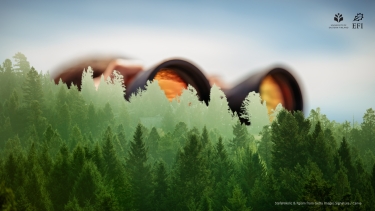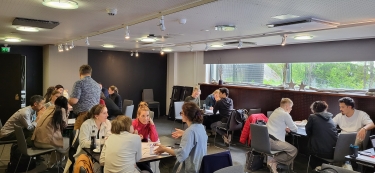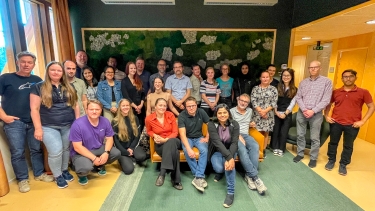Why and how forest fires are becoming a European problem?
Read reflections from Marc Castellnou and Pau Costa Foundation on why and how forest fires are becoming a European problem.
The summer of 2018 is proving that climate change is driving fire regimes faster than expected. The decline of rural economies and agroforestry mosaics in Europe are creating more continuous and dense forest landscapes. Climate change is more visible as it generates drought stress to those dense masses, and as a consequence large fuel loads are available for burning during wildfires. Worst of all, this phenomenon is not only affecting the South, but all Europe.
While the 2017 fire season was about Megafires as single event, the 2018 is about globalisation of such event. The first Pan-European fire season was during the summer months. The novelty is not that fires are happening in Northern Europe, in fact, 2007, 2011 and 2014 have been notable fire seasons in these countries. What makes the difference is the fact that during this summer Peloponnesus and Algarve have burned on the same day as the forests from Sweden, Latvia, the agroforestry mosaic from Denmark and a range of ecosystems of central Europe in between. This all happened during July 23 this year.
The emergency services refer to the Wildfire Paradox as the process in which the lack of forest management and the increase of fire suppression efforts derive into a change in fire regimes that burn in a higher intensity. The Paradox is given by the fact that a rapid suppression of all wildfires contributes to creating homogeneous and dense fuel loads. The effect on the midterm is a decrease on the number of wildfires. However, if extreme weather conditions are given, the fires are larger and develop a higher intensity from the combustion of the accumulation of fuel loads available in the continuous landscape.
The Wildfire Paradox can be explained by the Wildfire Generation concept. Different generations are identified to explain the wildfire evolution into large wildfires burning with high intensity (i.e. Megafires). In the first place wildfire became a threat due to the fuel continuity (1st generation). With time, fuel continuity increased leading to faster fires (2nd generation) and more intense fires (3rd generation). The third generation wildfires challenge fire suppression agencies as they spread fast and with a higher intensity over dense and continuous vegetation masses. These fires are typically a problem from Southern countries that are now also expanding to Northern Europe.
Climate change impacts on landscapes from temperate regions have observed this during 2018. Summers in temperate countries are traditionally wet, have all of a sudden been transformed into long, hot and dry periods. Large fuel loads have suddenly been available in a landscape without a previously defined fire regime. In these landscapes, fires do not burn as in 1st generation, but rather as 2nd and 3rd generation: fast and with high intensity. Northern countries, with large extensions of wildlands and forests have now a fire regime of increasing intensity. But fire services have not had the opportunity to approach the problem and build tactics and strategy. They are going from fire regimes of small and rare fires directly into Megafires. The only option seems to fight flames, but doing that there is a high risk of losing the big picture. In such scenario, a defensive strategy will help fighting flames, however flames are only the visible part of a deeper problem. It is not a problem of fighting flames, it’s a landscape problem.
Southern Europe is already in the 3rd generation, with two added weaknesses, the wildland-urban interface and the simultaneity of fire events. These two phenomena demand an exhaustive amount of resources and often cause the collapse of the emergency services. The more resources are deployed, the larger is the Wildfire Paradox. Fires in the wildland-urban interface are the 4th generation and simultaneity of fire events is the 5th generation (e.g. 3rd and 4th generation fires). The response is the international cooperation and the support to the suppression means. But this is not the solution, is only containment. Once the 5th generation of wildfires take place, the success of fire suppression depends mainly upon the likelihood of extreme weather events. And that is uncertainty at its best. So economy and landscape depend of uncertain weather events.
If we are keen to fight the real problem, this should be fought from the very beginning: acting on the fuel load availability, and have a better understanding of the fire ecology and the role of fire as natural disturbance. Landscape management and planning shall integrate wildfire risk. Fires are nothing strange nor exceptional, they are here to stay. Fire seasons that before happened only in the South are now a reality all across Europe. Firstly, to reduce the fire intensity and spread rates, it is necessary to reduce the load of dead fuel. Secondly, to reduce fuel continuity it is necessary to restore mosaic structures creating heterogeneous landscapes that include agriculture. In that sense, bioeconomy shall become a priority, as it contributes to reduce emergencies and the risks associated with climate change.
The lessons learned fighting wildfires on the past can be of great help. All are pointing at the recovery of the mosaic landscapes in order to keep fire generations at the minimum. Taking a defensive strategy will only contribute to enlarge the problem, and forest will no longer be an ally but an enemy, then Megafires happen. The evidence of failing to see the big picture is the focus on the demanding daily emergency.
The current trend under the context of climate change is to spreads from Southern to Northern Europe. Those forests that are not adapted to the new climate are experiencing renovation through disturbances. It is urgent that we face the current situation as a way to help forests and societies to adapt and change, rather than take the hard strategy of preserving the current forests. We shall aim to create the landscape of the future, resilient against large emergencies, protector from climate change and from Megafires. Forest management and the associated bioeconomy are tools to take action.
The fire suppression services shall be, of course, well trained and provided with the appropriate resources. However, their efficiency relies upon the preparation of the landscape to fight flames in it. Without prepared landscapes there is no possible suppression of the 6th generation fires, or ‘fire storms’. They were seen in Portugal, Chile, Canada and USA in 2017, and now again in 2018.
To use a simple medical parallelism, we shall take care of our health rather than waiting for the painkiller that will reduce the pain once we get sick.
Marc Castellnou was one of the speakers in our latest ThinkForest seminar. You can spot him from 48.00 on wards
Watch the recording: ThinkForest seminar: Role of bioeconomy in controlling forest fires
Madrid, Spain. 29 May 2018
Further reading:
Forest Fire Decalogue by Pau Costa Foundation


